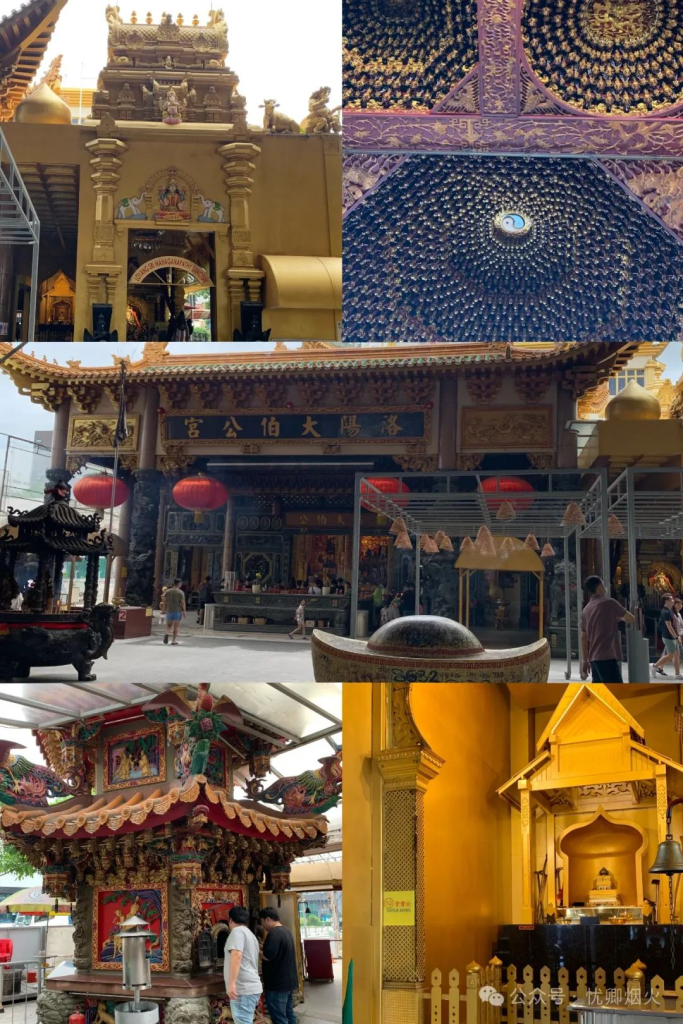
Singapore is called the Lion City, but there are no lions; A city-state where every inch of land is valuable, yet residents have their own homes that are spacious and comfortable (as seen in Singapore’s public housing estates); Singapore’s ethnic composition and geographical location make it easy for terrorism targets, but it is one of the safest countries in the world. Singapore is one of the smallest countries in the world in terms of land area, yet it holds the world’s strongest passport. Singapore is a highly civilized country, but it has corporal punishment; A country that values morality, but has legal gambling and red light districts
What impressed me the most when traveling in this paradoxical country? It is a religious venue. Generally speaking, every country has its own main religion, and the vast majority of religious sites are the main religion of that country. But in Singapore, it stands out with its astonishing number of religious sites and denominations. There are hundreds of religious sites in Singapore. Write down some of the religious sites you visited, and you can see a glimpse from a narrow perspective.
The Grand Duke’s Palace in Luoyang, where the four religions are integrated
The Grand Duke’s Palace in Luoyang is located on Loyang Road in Singapore and has nothing to do with Luoyang, China. Da Bo Gong is a deity in Chinese Taoism.

There is an Indian temple in the palace of the Grand Duke of Luoyang (see top left in the picture above). The major halls of Taoism and Buddhism are interconnected. Between the Indian temple and the Taoist temple stands a shrine – Datuk, which is the deity of Malays (see bottom right of the picture) and existed before Malays embraced Islam. There have been Malay temples here for a long time. Taoism, Buddhism, Hinduism, and early Malay religions all converge at the Grand Duke’s Palace in Luoyang, so it is a unity of the four religions.

In the hall of Guangjin Caiyuan (see picture), there is a lotus flower in the center of the top, and a large abacus surrounded by 12 zodiac signs. The abacus at the top is the largest abacus in Asia. There is a miniature round table with a roof pattern placed on the ground, and there is a coin slot in front of each zodiac sign. After the coin is inserted, a dial of abacus beads is played, symbolizing abundant wealth. At the exit of the Taoist temple, there is also a “Ten Directions Lonely Soul Pavilion” (see bottom right of the picture above), which was built for all those who came to Singapore to make a living and died alone, right?
Temples near Wanqing Garden
The Wanqing Garden is the place where Dr. Sun Yat sen has lived in Singapore for many times. It is the headquarters of the Nanyang Branch of the Chinese Revolutionary League. Now it has become the Sun Yat sen Nanyang Memorial Hall. Follow the navigation to take the bus, and after getting off, you will see a Guanyin Hall (see picture) opposite Zhongshan Shopping Mall.
There are several people burning incense and kneeling in Guanyin Hall. In the courtyard of Guanyin Hall, there is a sculpture of an elephant guarding the Buddhist niche. The Guanyin Hall courtyard is surrounded by towering buildings. Leave Guanyin Hall and follow the navigation to Wanqing Garden. Wanqing Garden is a two-story villa purchased by Singaporean businessman Zhang brothers for their mother in 1905. Wanqing Garden “is taken from a poem by Li Shangyin:” The will of heaven favors the secluded grass, and the world cherishes Wanqing. “It now belongs to the Singapore Chinese General Chamber of Commerce. Mid-Autumn Festival activity venue is being arranged in the yard of Wanqing Garden. The staff said it’s a great time to visit now because the memorial hall is about to be renovated and will reopen in two years.
I saw a temple under renovation next to Wanqing Garden. After visiting Wanqing Garden, I walked to the temple and saw that it was the Singapore Myanmar Jade Buddha Temple.

The temple gate is open, with colorful lights on the background of the jade Buddha, creating various auspicious patterns (see picture). The Buddha statue in the Jade Buddha Temple was carved from 10 tons of marble in Mandalay, Myanmar in 1918. When I saw it was Mandalay, Myanmar, I immediately remembered the scene from a few years ago. I wrote: Reading Orwell’s “Burmese Years” and Traveling to Today’s Myanmar (Mandalay Chapter). Singapore in 1918, like Myanmar at the time, was a British colony.
Church of England – St. Andrew’s Church

The founder of modern Singapore – Stemford, an Englishman Sir Stamford Raffles chose the location for the construction of St. Andrew’s Church in 1823. The church was founded in 1834 and was the first English church in Singapore. The existing St. Andrew’s Church was rebuilt in 1857, a magnificent Gothic style building constructed by laborers from India. In 2005, the Zhongmin Hall (as shown in the picture) was expanded and completed next to this church, with one floor above ground and two floors underground. The underground section reads: Cathedral, new temple. The expanded church also provides a resting place for the people in the city center.
There are some introductions in the courtyard of the church, among which it is seen that during the Japanese invasion, the Christians of the church made contributions to serving the people in the chaos of war.
The stained glass on the gate depicts the authors of the four Gospels (see picture above). There is a cross on the wall behind the church podium, from Coventry Church in England. The church was destroyed during World War II, and a cross made of iron nails from the ruins of the church hangs in the St. Andrew’s Church. This cross not only represents God’s love, but also warns people not to forget the sin of war!
Armenian Apostolic Church
Next to the “Singapore Chinese General Chamber of Commerce” building is an Islamic style building under renovation; Across from the building is an Armenian Apostolic Church, which was first built in 1835.

There are some sculptures in the courtyard of the Armenian church, among which the cross carried by Jesus is wrapped in thorns (see picture), which is different from other crosses. Several people are praying in the church.
French churches
Mathilde from France Sister Laklot and three accompanying nuns arrived in Singapore in 1852 and established a school for girls in 1854: the Convent of the Holy Infant Jesus Girls (CHIJ). What we see now (as shown in the picture) is the foundation of a women’s monastery that has been rebuilt multiple times, also known as the Praise Square.
Many people are taking photos in the yard, with the majority being women. This monastery now has an art gallery, a photography studio, etc. There are also above ground and underground restaurants in the courtyard, and many diners are enjoying them.
In Singapore, I have received a lot of help, filled with gratitude towards Singaporeans and a lingering interest, ending my paradoxical journey alone in Singapore.


